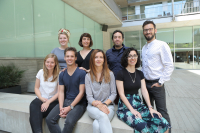 NOTICIAS
NOTICIAS
How do sperm and egg fuse together? New funding to uncover mysteries of fertilisation
Verena Ruprecht's lab at the CRG
Fertilisation is a well-documented natural process, yet despite its fundamental role in sparking life, little is known about the exact physical steps that occur when a sperm and egg meet for the first time.
To answer this question, researchers at the Centre for Genomic Regulation (CRG) in Barcelona have been awarded funding from the Human Frontier Science Program (HFSP), together with teams at the Fudan University in Shanghai and the Research Institute of Molecular Pathology (IMP) in Austria.
The project is one of eight Young Investigator Grants chosen for funding in the latest call of the Human Frontier Science Program (HFSP) and was ranked first among applications.
Verena Ruprecht, whose lab will coordinate the project from Barcelona, says: "The HFSP funding gives us the exciting opportunity to study sperm-egg interaction dynamics and the role of mechanical forces during the fertilisation process in a multi-disciplinary team bridging biology, physics and bioengineering."
Few studies have focused on the dynamic process in which the two gametes get together, interact and fuse. In particular, the role of the egg has been neglected, with sperm generally viewed as the motile and therefore more active partner during gamete encounter.
“Together, we will address a key open question in reproductive biology and investigate whether the egg also plays an ‘active’ role in the fertilisation process, for example by generating forces that might actively engulf the sperm”, says Andrea Pauli. Her team will provide crucial expertise in zebrafish fertilisation, which will serve as the main model system in the study.
As one of the core elements of the project, the researchers plan to pioneer a so-called ‘synthetic fertilisation synapse’, with the aim to reconstitute sperm-egg interaction dynamics. Applying state-of-the-art technologies such as high-resolution imaging and quantitative force measurements, the team of scientists is set to tackle the highly challenging problem of the biophysical control of fertilisation. Their research will provide fundamental insights into the dynamics of sperm-egg interaction and its mechanosensitive regulation. These insights promise to transform the currently rudimentary knowledge of the mechanism of fertilisation.
The project will be supported by the International Human Frontier Science Program (HFSP) over a period of three years.
The Human Frontier Science Program is an international program of research support implemented by the International Human Frontier Science Program Organization (HFSPO) based in Strasbourg, France. It aims to promote intercontinental collaboration and training in cutting-edge, interdisciplinary research focused on the life sciences.

